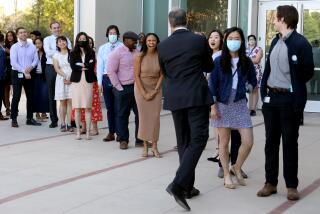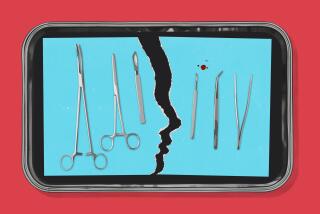Their Doctors May Be Foreign-Born, But Rural America Says ‘Welcome!’ : Medicine: New federal rule allows each state to sponsor as many as 20 foreign physicians, provided they meet licensing requirements and agree to practice in rural areas, where doctor shortage is chronic.
- Share via
TICONDEROGA, N.Y. — Like many other expectant mothers in northern Appalachia, Janice Hay drove 100 miles to see her obstetrician.
But on the winter night that her baby was born at home, 15 weeks prematurely, the drive to Burlington, Vt., would have been fatal. By the time Hay, a 37-year-old fitness instructor, got to the local hospital in an ambulance, the 1.8-pound infant wasn’t breathing.
Dr. Hemant Pandhi, a new general practitioner from India, began mouth-to-mouth resuscitation. In 10 minutes, Hay’s newborn son, Blake, let out his first cry.
“That’s why I came here,” said Pandhi, 46, who passed up a higher-paying offer in Albany, N.Y., to practice medicine in Ticonderoga, a logging town of 4,600 people on the Vermont border. “I feel more satisfaction at the end of the day.”
Across rural America, people are relying more and more on doctors like Pandhi for their medical care.
According to the latest count of the American Medical Assn., about 105,400 doctors in the United States--one-fifth of the total--are naturalized citizens or are here on special visas.
About 35% of the foreign-born physicians work full time on hospital staffs, mostly in cities. At first they were concentrated in specialties such as radiology, anesthesiology and pathology.
But now, according to the AMA, they’re moving toward primary-care specialties such as internal medicine, family practice and pediatrics.
Roughly 20 million Americans--one in 12--live in rural communities suffering from a shortage of doctors. Rural hospitals have been shutting down.
Rural areas have 97 physicians per 100,000 residents, compared with 225 per 100,000 in cities, according to the federal Office of Rural Health Policy.
By some estimates, 5,000 to 10,000 family practitioners are needed in rural areas, especially in Rocky Mountain and Midwestern states, Georgia, Texas and parts of New York and Florida.
The number of foreign doctors peaked in the early 1970s, then dropped off as the United States tightened its immigration laws. Since 1989, there has been a renewed influx of immigrant physicians.
Although the AMA does not keep records of doctors’ nationalities, the Educational Commission for Foreign Medical Graduates, in Philadelphia, lists the leading contributors of physicians certified to enter U.S. residency programs.
In 1993, they were India, Pakistan, the Philippines, parts of the former Soviet Union and China.
“The doctor shortage in rural areas is a worldwide phenomenon,” said Eric Goon, director of the Division of Human Resources for Health at the World Health Organization in Geneva. Even in developing nations, many cities have a surplus.
Many foreign doctors first come to the United States as medical students. But some American communities have begun recruiting licensed physicians from abroad.
Since Jan. 1, a new federal regulation has allowed each state to sponsor as many as 20 foreign physicians, provided they meet state licensing requirements and agree to practice in rural areas.
American physicians tend to avoid these areas because of low pay, high caseloads and isolation, said Dr. Ciro Sumaya, administrator of the federal Health Resources and Services Administration in Rockville, Md.
“If your patient is crashing, you can’t call in a specialist. So you’d better have your skills sharp,” said Dr. Vani Nagala, 37, of tiny Oakes, N.D., where the closest major hospital is in Fargo, 120 miles northeast.
Nagala and her husband, Rup, also a physician, moved to Oakes from India in 1985 and bought the local clinic. At first, the community was suspicious about their being foreign, Vani Nagala said. “But as each patient got better, it sank in that they could count on us for health care.”
For seven years, the Nagalas worked seven days a week without a vacation. When they finally advertised for help, they couldn’t entice any American doctors to Oakes. They recruited two physicians from India and one from Jordan.
Dr. James Winn of Euless, Tex., executive vice president of the Federation of State Medical Boards, says that importing physicians may not be the answer to rural doctor shortages. It takes physicians away from places where they may be needed more but doesn’t reduce the doctor surplus in American cities, he says.
In the last 10 years, the number of American physicians has increased by almost one-third.
There is also concern that doctors from overseas lack the training of their U.S. counterparts. Some patients complain of language problems.
Winn says there has been a recent upswing in lawsuits against doctors who were trained abroad, including U.S. doctors who went to medical school in the Caribbean or Mexico.
But Martin Hatlie, an AMA attorney in Chicago, said, “There is no evidence that foreign medical graduates have a higher frequency of malpractice suits.”
To screen out poorly trained doctors, the Federation of State Medical Boards wants to stiffen its two-step licensing examination. By the year 2000, the federation plans to begin testing clinical skills as well as book knowledge. Foreign doctors will be required to speak English, not just read and write it.
Fearing that the new test may worsen the doctor shortage and discriminate against non-English-speaking physicians, state examiners in Florida are devising an alternative test for physicians who can’t pass Step 1--basic science--of the national exam.
“I think it’s dangerous to give these individuals any license,” Winn said. But for many rural communities, he said, the choice has come down to poor care or no care.
Last year, residents of Ocanto, a small town in Wisconsin, recruited two German physicians. Both left within 10 months.
A wealthy Ocanto resident has established a trust fund to pay a new doctor an annual salary of $100,000, plus $25,000 for insurance, for the first three years. “We want to find someone who will fit in the community,” said Dr. Jim Wallace, who practices in a nearby town.
In Ticonderoga, Dr. Ranpali Fernando, a surgeon from Sri Lanka, says that fear of violent crime and of infection from AIDS patients drove her away from a practice in Brooklyn, N.Y.
“I’d do 10 gunshot wounds in a day,” she said. “You’d get sick of that too.”
More to Read
Sign up for Essential California
The most important California stories and recommendations in your inbox every morning.
You may occasionally receive promotional content from the Los Angeles Times.










